How to Improve Bathroom Lighting: A Holistic Approach
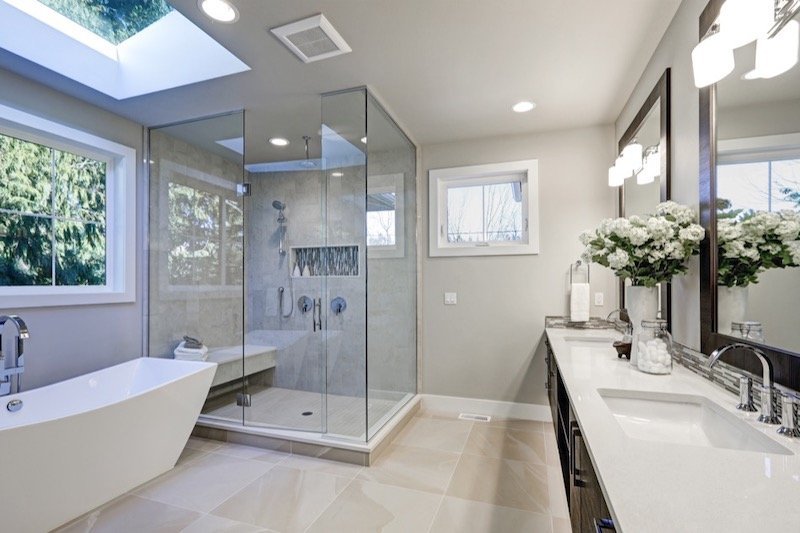 As the main place people go to get ready for their days and nights ahead, bathrooms need excellent lighting to best serve everyone’s needs. In the morning, many people head to the bathroom first thing to wash up, get dressed, and do their hair and makeup. In the evening, the bathroom often becomes a quiet retreat where it is easy to relax and become rejuvenated after a long day.
As the main place people go to get ready for their days and nights ahead, bathrooms need excellent lighting to best serve everyone’s needs. In the morning, many people head to the bathroom first thing to wash up, get dressed, and do their hair and makeup. In the evening, the bathroom often becomes a quiet retreat where it is easy to relax and become rejuvenated after a long day.
Every bathroom experience can only live up to expectations when the lighting is just right, however, but that is not always so easy. To learn all you need to know to achieve this goal, browse these tips, ideas, and guidelines on how to best set up bathroom lighting in every household.
Table of Contents
- What is Good Bathroom Lighting?
- Light Levels
- Harnessing Natural Light
- Know Your Fixtures
- Vanity Lighting
- Bathtub and Shower Lighting
- Task Lighting
- Ambient Lighting
- Accent Lighting
- Night Lighting
- LED Lighting
- Bathroom Lighting Faux Pas
- Bathroom Lighting and Applying Makeup
- DIY vs When to Hire a Professional
- Safety Considerations
- Putting it all Together
What is Good Bathroom Lighting?
Good bathroom lighting has the flexibility to adjust to the task at hand whether people are getting ready for the day or winding down at night. The lighting needs to be bright enough to accommodate all activities by the vanity and shower areas, yet dim down as the occasion calls for it.
In general, bathrooms call for symmetrical lighting positioned along the walls rather than a single fixture overhead. The layout of each bathroom determines how to best add these elements to achieve the desired effect at every corner of the room.
Balance is key when optimizing the bathroom lighting in any household. Less is not necessarily more, however, though it is still possible to overdo it. An excellent lighting layout for a bathroom might include:
- Soft overhead lighting from multiple fixtures
- Bright task lights around the mirror
- Additional task lights around the tub and shower area
- Accent lights to dress up key decorative elements
To achieve true balance in the bathroom lighting design, always aim to create layers of light. As household members switch between activities, they can adjust the lighting with the flick of a switch, creating their ideal atmosphere. Dimmer switches are another way to allow for the quick customization of the lighting in the room at any given time.
Light Levels
In the name of ergonomics, or optimized comfort and efficiency, the light levels in the room must match the task. This is especially important in the bathroom where tasks might require excellent vision and a steady hand.
Getting the light levels just right can prove challenging, however, especially in small spaces. There must be just the right number of lights in the right places with the correct bulbs or the space could have too little or too much light.
In the task-lighting areas, aim for 700 lux, or lumens per square meter, which is almost as bright as full daylight. Allow the lighting to dim down to 300 lux at the lowest to create an ideal space for rest and relaxation. For best results, consider using dimmable 75 to 100 watt bulbs in each fixture.
To keep the selected light levels static, remember to clean the bulbs and fixtures on a regular basis. Otherwise, dirt on the globes and other components can block light and make the bathroom look dim and dingy. Also, check the light output of each bulb after cleaning them up to see if any are in need of replacement.
Harnessing Natural Light
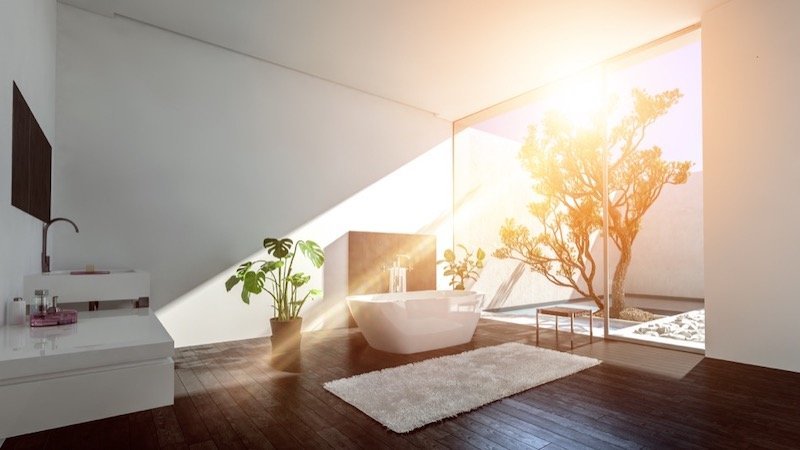
Before optimizing the fixtures and bulbs, look at the natural light in the room and see how to best harness it. Using natural light as much as possible provides household members with many exceptional benefits, such as:
- Setting the body’s circadian rhythm and optimizing sleep/wake cycles
- Promoting the production of vitamin D for improved bone health
- Aiding in the healthy development of the eyes, which prevents nearsightedness
- Increasing production of serotonin for better moods
- Making people feel more productive, which can last well into the workday
Ample natural light also helps make the bathroom feel more spacious and open, creating the ideal space for rest and rejuvenation. It can decrease the money spent on lighting the bathroom during the daytime hours. Furthermore, when there is more natural light, there is less mold and mildew, making cleaning sessions much faster and easier.
To boost the natural light in the bathroom, look into adding more windows, changing the window treatments, or even adding skylights. As these elements bring more light into the room, they will greatly improve the bathroom’s beauty and function. Once natural light is maximized, turn your attention to selecting the right fixtures for every corner of the bathroom.
Know Your Fixtures
When replacing or adding fixtures, study all the available options on the market today to find the best configurations for the bathroom in question. Here’s a look at the most popular options for residential bathrooms.
Pendant
Hanging from the ceiling by a cord or chain, pendant lights can provide the perfect amount of overhead light when placed in the optimal location. These lights work well along the center of the room or on either side of the mirror. Their height is adjustable to suit the space perfectly, creating beneficial layers of light.
Recessed
With their canisters that sit flush with the ceiling, recessed lighting can provide the ideal amount of overhead light without the clutter. The light simply shines down from the ceiling and brightens up the space. As they can create a swiss-cheese-like pattern in the ceiling, overdoing it is easy with this type of fixture. Use the minimum number to create enough ambient light, and then fill out the rest of the room with task lighting.
Sconces
When it comes to task lighting, wall sconces are the way to go. These fixtures attach to any wall and shine light outward to brightly illuminate the immediate area. They come in many different shapes and sizes to suit a wide range of room designs and décor.
Although other fixture options, like chandeliers, are not used as often in bathrooms, there is no real reason they cannot be installed. As long as the fixture suits the space and provides the right amount of light, it can be used to elevate the look and function of the bathroom.
Vanity Lighting
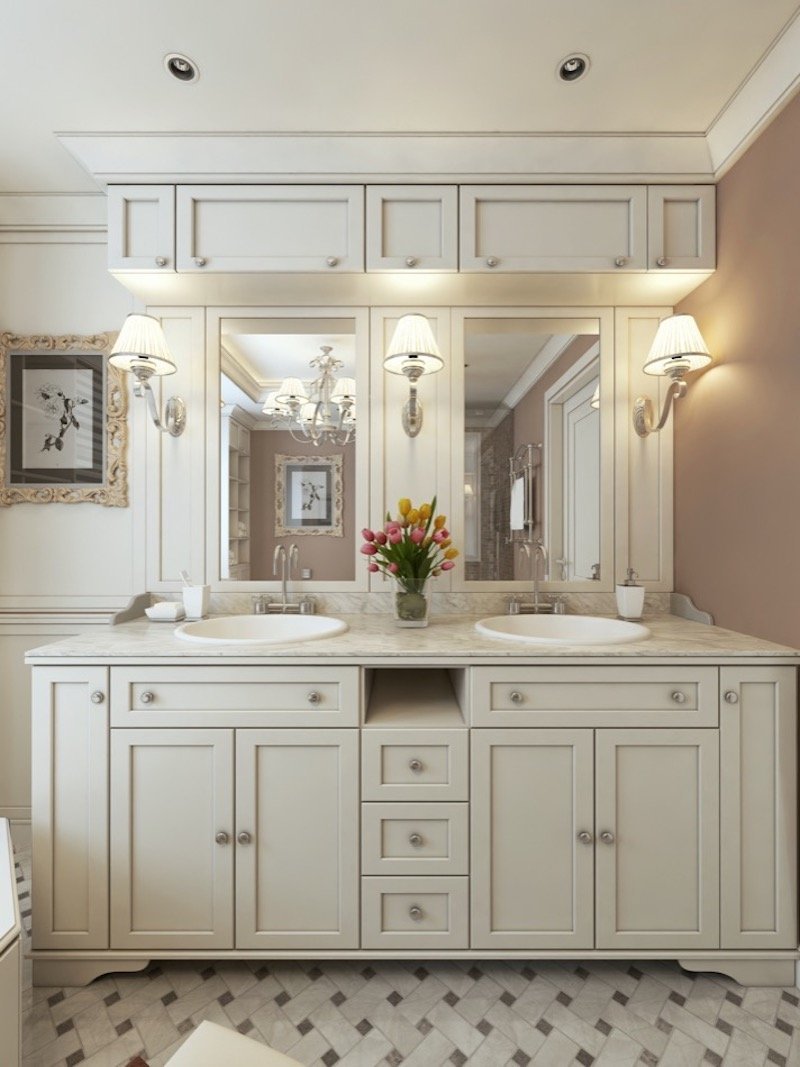
The vanity area in the bathroom needs incredibly bright task lighting to allow people to complete a variety of tasks, including:
- Plucking their eyebrows
- Removing splinters
- Taking out or putting in contact lenses
- Putting on makeup
- Styling their hair
When lighting around the vanity remains at ideal levels, eyestrain and effort is reduced considerably. Achieving the desired results is also a lot easier when there is enough light around the mirror.
In order to optimize vanity lighting, address the following areas and customize the selections to the bathroom layout and needs of the household.
Flank Bathroom Mirror with Lights
When completing grooming tasks that require great eyesight and fine motor skills, people tend to park themselves right in front of the bathroom mirror. Their efforts can only achieve the desired results if they have enough task lighting on tap, however. Thankfully, surrounding the mirror with the right light fixtures and bulbs is all that needs to be done to create the optimal personal grooming environment.
At the top and sides of the mirror, add purpose-built lights to brightly illuminate the surrounding area, such as:
- Vertical wall sconces
- Vanity mirror lights
- Bath bars
When installing lights along the sides of the mirror, mount them 28 inches apart at the minimum and about 60 inches from the floor. The light fixture along the top should be centered right above the mirror and mounted 78 inches from the ground. This will ensure the fixtures cast the perfect amount of light on the person standing in front of the mirror.
Model Your Bathroom Lighting After Daylight
To make a positive impact on mood, grooming habits, and more, bathroom lighting needs to be modeled after daylight. To do so, simply use natural light as inspiration and select the bulbs that mimic the ambiance desired in that space.
When it comes to household lightbulbs, there are three main options:
- Incandescent lightbulbs
- Compact fluorescent bulbs
- LEDs
Within each category are many different brightness levels and color ranges to consider. To mimic daylight in the bathroom, only select incandescent bulbs labeled cool white, as the others will cast a yellow hue.
In using LED bulbs, on the other hand, look for ones in the 4000K to 6500K color temperature range. These bulbs will brighten the bathroom without emitting unnatural hues, optimizing the comfort and function of the bathroom space. Compact fluorescent lights are not suitable for bathrooms, however, as they are typically unflattering.
Layer Vanity Lighting
When designing the vanity lighting, aim to create layers of light with several fixtures along the walls and ceiling. With different layers, people can quickly and efficiently adjust the lighting to their needs, elevating the bathroom experience.
To create the first layer, use recessed lights or similar fixtures in the ceiling for ambient light. Then, build upon the light, and reduce shadows in key areas, with vanity lights at the top and sides of the mirror. If accent light is needed, carefully position bath bars, spotlights, or similar fixtures along adjacent walls so they do not directly reflect in the mirror.
In order to use the layers effectively, each set of lights needs to run on a different switch. An electrician can install additional switches, if needed, or even change the existing ones to dimmable models. Use bulbs in different hues and wattages as well to create a pleasant environment that can be adjusted bright enough for all tasks.
Bathtub and Shower Lighting
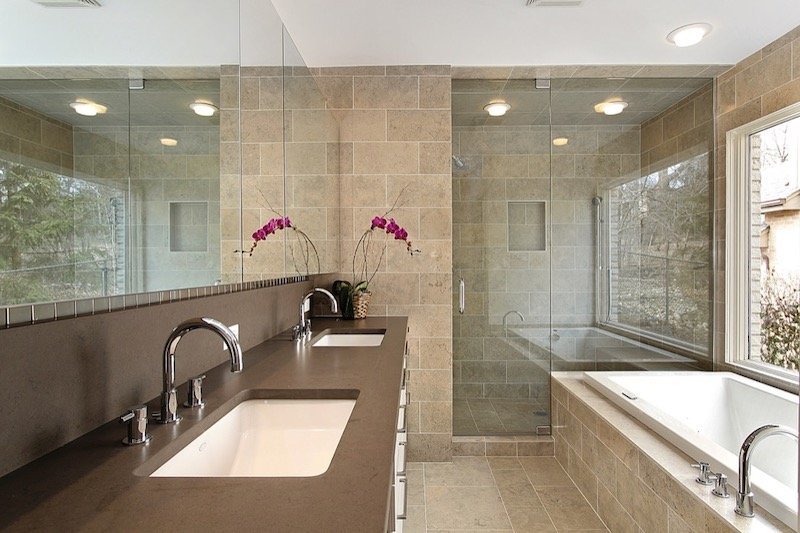
Only recently has bathtub and shower lighting started trending but it seems like it should have been the thing to do long ago. Without adequate lighting in this area, many find it difficult to complete their regular grooming tasks.
Not all lights will work around the shower, however, as the location is considered wet, rather than just damp. In wet areas, the water can easily splash onto the fixtures, creating unsafe conditions — unless the fixture is rated for use in such locations, that is.
Lights rated for use in wet locations have enclosed fixtures and gaskets that help keep the water out. Recessed canister fixtures are the most popular style for around the bathtub and shower due to their low-profile design. Decorative fixture options are also available, but they are often much more expensive than waterproof recessive lighting.
Recessed lights do not have to be reserved for the ceiling either. They can be installed in the walls or even in the shower floor to add layers of light to the bathroom space. Rainfall LED shower heads can brighten up the bathing area even more and add a bit of whimsy to the design.
Task Lighting
In order to properly apply makeup, shave, and complete other grooming activities, excellent task lighting is a must. Task lighting brightly illuminates the space, casting away all shadows that could impede visibility. The fixture must be positioned at the right height and fitted with the 75 to 100 watt bulbs to provide the intended benefit, however. Otherwise, the light might not be bright enough for the task at hand or even cause eyestrain.
Since exceptional task lighting should eliminate all shadows on the area in need of attention, multiple fixtures are often needed to achieve the desired effect. Around the mirror, for example, a light just at the top would cast shadows on the face, making grooming activities that much more difficult. By positioning the lights at either side of the mirror instead, or in addition to the upper light, shadows are eliminated, making the task at hand easier.
Ambient Lighting
Ambient light fills the room with enough light to see clearly while moving around or completing general activities. Depending on their position, and the architectural elements in the room, ambient light fixtures can directly or indirectly illuminate the entire room. Shadows are often plentiful, however, until task and accent lighting is added to the mix.
In establishing ambient lighting, first consider the natural light coming into the room through windows and skylights. Look at how well the natural light fills the space in the daytime, noting any areas in need of additional light. Also, think about how much illumination the space needs after sunset leaves it absent of natural light.
After that, it is possible to add fixtures in all the right areas to softly bathe the space in ambient light. Day and night, the ambient light should evenly fill the space and remain at the perfect brightness level.
Accent Lighting
Accent lighting draws attention to the decorative elements in the bathroom, elevating the look and feel of the space. For that reason, these lights should always be used sparingly to create the intended effect. A large bathroom, for example, should only have one or two accent lights highlighting the most interesting areas or decorative elements.
In finding the perfect spots, consider positioning the small lights over artwork, for example, or around architectural elements of note, helping draw the eye to those areas. Accent lighting also works great to highlight décor tucked in alcoves and even as a functional light around bathroom shelves.
Accent lights should always be bright, but focused. Their light should not escape the area and cast shadows on other elements in the room. Rather, it should focus on the decorative element in question, illuminating it beautifully without seeming too bright or harsh.
Night Lighting
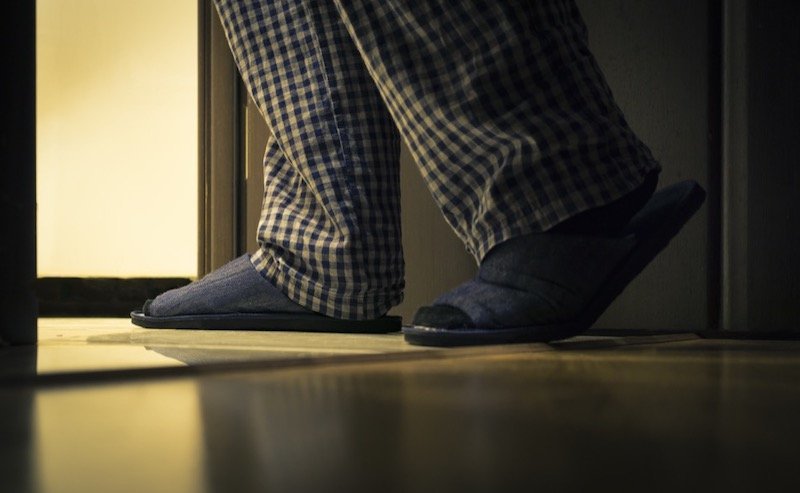
To best support the health and wellbeing of everyone in the house, the lighting in the bathroom should always be ready for late-night trips by the household members. Simply flipping on the regular lights in the middle of the night can disrupt the sleep-wake cycle and make it difficult to get enough rest. While layers of light can help, they are not always enough to ensure people remain undisrupted by these late-night bathroom trips.
To optimize the night lighting in the bathroom:
- Put the ambient lights on dimmer switches
- Place motion-activated nightlights in the bathroom and hallways
- Use LED tape lighting under the vanity cabinet
- Put independent low-light fixtures on a motion-activated switch
With these elements in place, everyone in the household can make their way to the bathroom and back to bed without light-shocking themselves completely awake. They can get back to sleep much easier as a result, which can have a positive impact on their overall well-being.
LED Lighting
In a bid to improve energy efficiency and light quality in the home, many households have switched to LED lighting over incandescent bulbs. The light emitting diode, or LED, bulbs boast a 90 percent higher efficiency rating than incandescent, making them an obvious choice for money-conscious households. LED lights are also a great upgrade because they:
- Fill the area with pleasant white light that is easy on the eyes
- Do not emit heat into the room or get hot to the touch
- Produce directional light that hits all the right areas
- Can last up to 10 times longer than incandescent bulbs
Since LED bulbs produce light in a specific direction, you can often find ones purpose-built for specific tasks, such as task lighting around the bathroom vanity. Consider the direction and intensity of light emitted by each bulb to find the perfect combination for all the bathroom light fixtures.
Look for LED bulbs that have a high color-rendering index as well to ensure all hues are accurately depicted. This is especially important if the bathroom will be used for the application of makeup or other color-intensive activities. Furthermore, if the fixtures are on dimmer switches, it will be necessary to select a dimmable LED bulb, as not all offer this function.
Bathroom Lighting Faux Pas
To keep the space functional and comfortable for all activities, certain types of light should never be used in the bathroom. Skip any light that fails to flatter, or worse yet, makes imperfections stand out. The light should make everyone feel good about themselves as they stand in front of the mirror. And it should be customizable to suit the intended activities, from taking a relaxing bath to putting on detailed makeup in front of the mirror. To achieve that goal, skip the following types of light in favor of ones that will provide the intended results.
Fluorescent Light
Found in public restrooms all over, fluorescent lighting is one of the worst offenders when it comes to providing an unflattering view. The blue light emitted by the bulb tends to wash out the skin tone and highlight even the slightest imperfections, such as dark circles under the eyes. Fluorescent lights also have a low color-rendering index, which is not ideal for applying makeup or other detail-heavy activities. Unlike LEDs, special fluorescent lightbulbs are not available to overcome this problem, so skipping this type of light is the best bet.
Yellow Light
In designing bathroom lighting, color temperature really matters — and for that reason, yellow light is out. This warm light can create a soft, inviting space, but it is not really helpful for detailed activities. The yellow tones can skew features, highlight imperfections, and make it difficult to pay attention to what matters. Bathrooms benefit from lights that emit cooler tones instead, mimicking the hues emitted by natural light. Look for bulbs listed as 4000K to 6500K to avoid light in the yellow spectrum, and keep the hues as cool and bright as daylight.
Pink Light
Pink light is both flattering and relaxing. This warm hue softens the features and smooths out imperfections, helping boost confidence along the way. Stress and worries tend to lift away as well, as the soft pink light bathes the room in its glow.
Despite that, it is not the best choice for bathrooms. The pink light’s warm spectrum and low intensity make for poor task lighting, after all. The interesting hue also throws off the color spectrum, making it difficult to apply makeup accurately.
If this is a must-have element, reserve the pink lightbulb for one fixture that can be flipped on and off independently from all the others. That way, people can use the pink light purposefully whenever they want to chill out or simply see themselves in a different light.
Downlighting
Known as downlighting, recessed lights are generally a great choice for bathrooms, but their placement is key. In the wrong location, these lights can create glare and shadows that make the bathroom look and feel quite unpleasant. When positioned just above the mirror, for example, downlighting casts hard shadows on the face and neck.
Although this can be mitigated somewhat with additional lights at the side of the mirror, it is best to just avoid improper downlighting placement. To effectively use downlighting in the bathroom, remember to:
- Only use one recessed light per four feet of ceiling space
- Keep fixtures at least two feet from the perimeter walls
- Use additional light fixtures to eliminate shadows
- Consider fixtures with a narrow beam angle for task light areas
Also, put all downlighting on the same dimmable switch to allow everyone to adjust the brightness to their needs.
By avoiding these mistakes, the bathroom lighting will be optimized to the needs of everyone in the household.
Bathroom Lighting and Applying Makeup
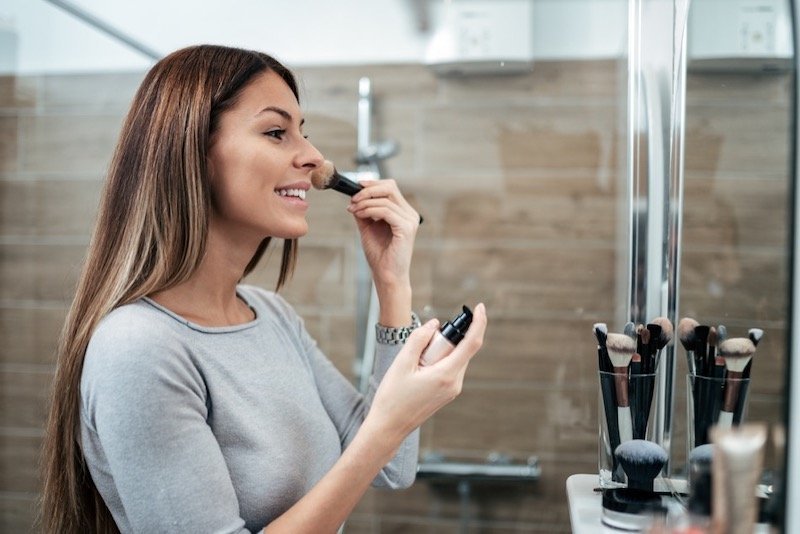
To perfectly apply their makeup, people need to have a steady hand and the perfect level of light in the room. When lights are the wrong hue and intensity, it can be difficult to accurately pair the colors and follow the right lines. Makeup effects created in the wrong bathroom lighting may not even look right upon stepping outside the room, wasting all that time and effort.
So, when it comes to makeup, it is well worth the time to get the bathroom lighting just right. Use these tips to achieve this goal and create the ideal area for applying makeup.
Buy the Right Bulbs
The right lightbulbs make all the difference in creating the ideal environment for applying makeup. High color-rendering index LED bulbs work best, as they have the perfect white light spectrum and accurately depict colors. With other bulbs, the warm light hues can skew perceptions, resulting in the incorrect application of base and accent colors.
Upon installing high-quality LED bulbs, everyone can create their desired makeup effects with ease — and the results will look just as stunning upon exiting the bathroom. Their colors will stay true, ensuring that their look matches their vision in all types of light.
Use Natural Light to Your Advantage
When applying makeup, use natural light as much as possible to achieve the best results. When in natural light, skin tone and makeup colors show up true, making it easier to achieve the desired effects. This type of light allows the eye to pick up fine details without causing eyestrain common in other spectrums.
Natural light is only effective for applying makeup if it can evenly stream across the face without creating shadowy areas. If the bathroom windows and skylight cannot brighten the whole room, additional task lighting may be needed to see clearly enough to apply makeup.
Natural White Light is the Next Best Thing
If natural light is not plentiful in the bathroom, then it will be necessary to rely on artificial lighting instead. The artificial lighting should be in the same spectrum as the natural light to support the makeup application process.
To find this spectrum, look for high color rendering index LED bulbs in the 4000K range at the minimum. At 4000K, the lights emit the same hue and intensity light as is found in natural daylight. The light grows ever cooler as the number rises, topping out at 6500K for bathroom areas. Although the number keeps rising from there, bulbs higher than 6500K are too bright for bathrooms.
Stand Directly in Front of Your Light
Shadows are a detriment to anyone trying to put on a full face of makeup or even just a bit of eyeliner. As the shadows cast across the face and neck, they limit visibility and make it difficult to apply makeup accurately and evenly.
To prevent this issue, make sure to stand directly in front of the light. The mirror should have light coming from above and the sides to minimize shadows when standing right in front. If not, then optimize the fixture placement to create a brightly lit task area well-suited for the application of makeup.
Use a Lighted Makeup Mirror
If the bathroom light cannot live up to expectations, switch to a lighted makeup mirror instead. These purpose-built mirrors have bulbs situated all around the frame, creating the ideal lighting environment. They are also highly portable and can even be used outside when conditions are right.
For the best results, look for one built using high color rendering index LED bulbs in the 4000K intensity range. Otherwise, the lights could fail to accurately show each hue, complicating the makeup application process. Also, verify that the mirror can be easily recharged to keep it ready to go at all times.
DIY vs When to Hire a Professional
If the bathroom lighting could use some improvements, many fixture, switch, and bulb upgrades are available on the market today. Not all can be completed by those savvy with DIY projects, however, as they demand the skills of a qualified electrician.
Many people find it easy enough to change out lightbulbs or even replace a fixture with a similar type. Anything above that is likely best left to the professionals, such as:
- Replacing a normal switch with a dimmable model
- Installing replacement fixtures that differ from the previous type
- Placing new fixtures and switching in the bathroom
Also, call in electricians any time the lighting upgrades require new wiring or repair to the old wiring. They can also make adjustments to the breaker box as needed to accommodate new light fixtures and switches.
When in doubt, simply call in the professionals to handle the bathroom lighting upgrades and all associated tasks. They will complete the job to your satisfaction and make sure it complies with all local building codes. This will provide true peace of mind that the upgrades are completed to the right standards and will function just as expected.
Safety Considerations
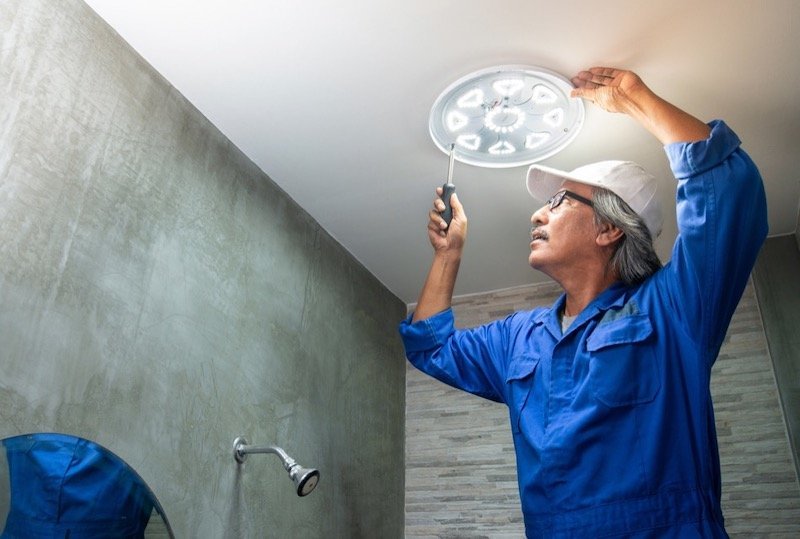
When dealing with lighting and electrical work, safety must always remain a top priority. Any mistakes could result in electric shock, fire, or other serious issues, so it is well worth the time and effort to stay safe. Furthermore, all residential renovations and upgrades must abide by local building codes or the city could order reversal of the work. So, keep all the following safety considerations in mind whether you are completing the work yourself or hiring a professional.
Electrical Code Requirements for Bathrooms
Electrical codes are complex and differ from region to region, which is why DIY enthusiasts can quickly get into trouble while completing bathroom lighting upgrades and repairs. These codes are vital, however, as they protect the household from serious hazards, like fires and electric shocks. Also, if the work does not comply with local building codes, the city could order the homeowners to perform additional repairs or even reverse the changes.
Each city sets its own codes for electrical work, which are usually based on the National Electric Code, or NEC. These codes go under revision every three years to ensure they stay up to date and provide the most protections. Despite these frequent revisions, electricians know their local codes well to ensure all work complies with the rules and passes inspection.
In many areas, bathroom electrical code requirements address the:
- Installation of enough circuits to safely serve the space
- Assignment of fixtures and switches to each circuit
- Use of AFCI or GFCI-protected outlets
- Placement of outlets, switches, and light fixtures
- Wiring of exhaust fan and other key electrical components
When remodeling a bathroom in an older home, it is common to find that the wiring and other elements do not meet the current electrical code requirements. Cities do not usually require homeowners to bring everything up to code when completing minor upgrades, like replacing a broken light fixture, but major renovations are a different story.
Guidelines for Bathroom Lighting
When installing bathroom lighting, there are many guidelines to keep in mind. The installation considerations vary a bit between the different types, so use this guide to find the perfect arrangement.
Globe and Strip Lights
Globe and strip lights can effectively illuminate small mirrors when placed along the top and sides. Choose lights that are at least 16 inches long and fit them with the preferred bulbs. Then, position the lights at eye level, or approximately 60 to 64 inches from the ground to the center of the fixture.
Wall Sconces
Alternatively, choose wall sconces for around the mirror to create the desired design and effect. Any design sconce can work as long as it is positioned properly around the edges of the mirror. When choosing the ideal position, balance design with utility. Make sure the sconce is close enough to the mirror to brightly illuminate the space without casting shadows or reflections.
Pendants
When properly installed alongside either side of the mirror, pedant lighting can beautifully dress up the space and provide enough light to see the finer details. To provide just enough brightness without glare and shadows, install pendants with the bottom of the shade at eye level. The light will diffuse outward, creating an area lit brightly enough for applying makeup and other intensive activities.
By following these guidelines, the bathroom lighting will easily live up to the expectations of everyone in the household.
Guidelines for Lighting Over Tub and Shower
Even more care must go into selecting the right fixtures for around the tub and shower as well as having them properly installed. To work correctly and without risk to household members, the lights must be rated for use in wet areas, not just damp locations. These wet-rated lights are typically fully enclosed units that use a gasket to keep water from entering the case.
Before installing lights above the tub or shower, verify the ceiling fixtures will sit at least six feet above the water lines running through the walls. In some areas, small, waterproof accent lights are exempt from this rule and can be installed in the floor of the shower. For all lights in wet areas, make sure the wiring for the fixtures and switches runs on a circuit that protects against electric shock. When installing the switches for these lights, position them at least three feet from the edge of the bathtub or shower area.
To properly illuminate the area for grooming tasks, use 60 to 75 watt lightbulbs in the ceiling fixtures. Lower-wattage bulbs in a variety of colors can be used for the fixtures in the shower floors to create the perfect atmosphere in that space.
UL Listings
Fixtures have to be built a certain way to safely operate in humid conditions or even in the presence of water. To help everyone differentiate between the different types, the Underwriters Laboratory provides a UL listing for each light fixture. This listing determines whether the light should be installed in dry, damp, or wet conditions.
Dry
Lights designed for use in dry locations usually just have the “UL Listed” designation on the packaging. In some cases, lights will not have any designation listed, which indicates they are likely only safe for use in dry rooms.
These fixtures can only be safely used in areas that do not have any direct exposure to water, such as the:
- Dining room
- Living room
- Hallway
- Bedrooms
The UL Listed fixtures can withstand normal humidity levels without malfunctioning or creating unsafe conditions.
Damp
Damp-rated light fixtures are suitable in indoor and outdoor areas that have a lot of moisture, such as the:
- Garage
- Porch
- Laundry room
- Bathroom
Since they do not have fully enclosed fixtures, lights with the UL Damp rating cannot withstand direct contact with water.
Wet
In areas where water could directly contact the fixture, like above the bathtub, it is necessary to use lights with a UL Wet rating. These fixtures are fully protected from moisture, thanks to their enclosed case and thick gaskets.
In bathrooms, plan to use either damp- or wet-rated light fixtures in the preferred styles. Dry UL Listed fixtures cannot withstand the high moisture levels and are not safe from direct exposure to water.
Putting it all Together
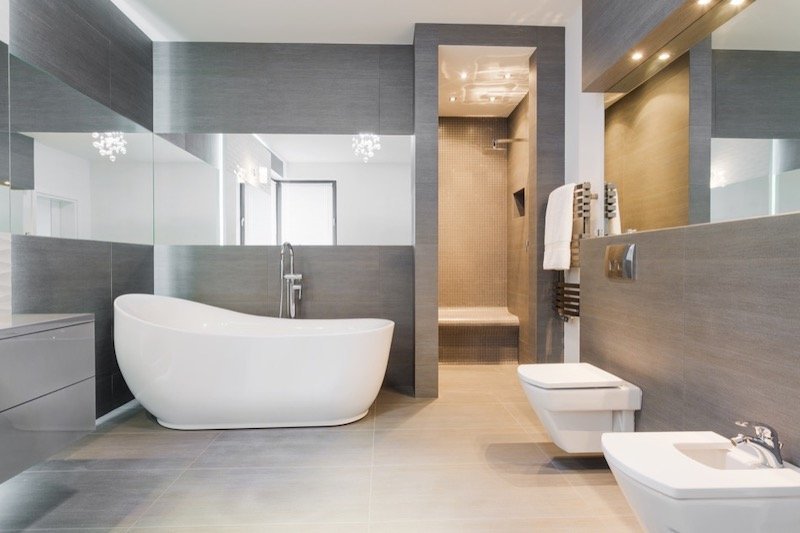
In moving forward with this project, use the tips and tricks above to create the best lighting possible for every bathroom in the home. Always go the extra mile in staying safe and completing the work to code to ensure the results live up to everyone’s expectations. Also, remember to choose the best bulbs for each fixture to customize the space to the household’s needs.
By taking the time to optimize lighting in the bathroom, the space can work for a multitude of purposes from relaxation after a long day to putting on makeup for an evening out. The perfect bathroom lighting is not easy to obtain, but it is well worth the time and effort.
